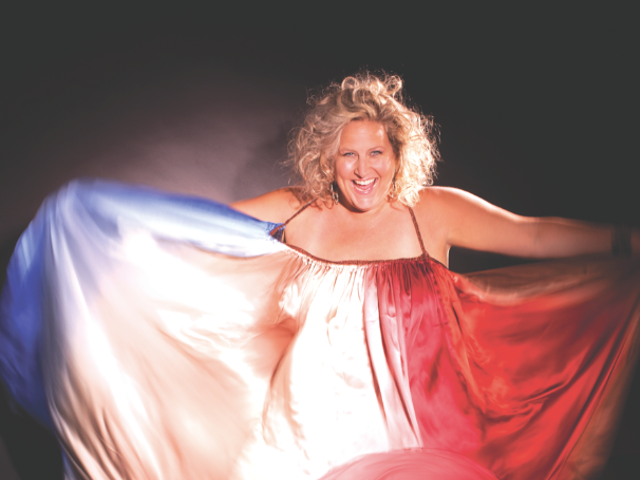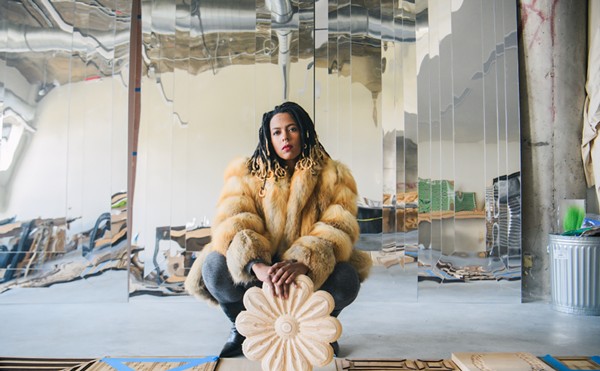Sarah Rose Sharp was living in New York City when she stumbled upon a seemingly innocuous crate of Betty Boop keychains in an alley behind a Koreatown tchotchke shop.
But the figurines, which were to be sold at the shop, weren't the iconic cartoon character as most of us know her — the flirty, raven-haired minx wearing a red dress and gold hoop earrings. Instead the tiny effigies were outfitted in assless chaps, adorned with stomach tattoos, and posed provocatively. Some wore nothing more than a bra, panties, and thigh highs, while others had on miniscule shorts with the button suggestively undone.
"I asked myself, 'Why do these exist?'" Sharp says. "If you look at these keychains, a great deal of thought and design went into them."
While Sharp was initially horrified at the overt sexualization of the cartoon character, she couldn't walk away from the tchotchkes.
"They definitely made me feel some kind of way," she says. "So, I bought them. They were 33 cents a piece."
That was 10 years ago, but those keychains haven't been collecting dust in a desk drawer or lying forgotten in a cardboard box. Instead, they've served as the catalyst for the artist's first-ever Detroit solo exhibit, which she's calling Girlfriend Material: A Fabric of Identity. She's aiming for a show that will provoke and challenge our perceptions of female roles — but with some humor and a touch of whimsy.
In addition to Betty Boop, Sharp has spent the last 10 years collecting materials that feature other iconic cartoons — namely Wonder Woman, Lisa Simpson, Princess Leia, Peanuts' Lucy van Pelt, and Minnie Mouse. She analyzed their depiction on everything from fabrics to calendars to coin-collecting boards.
Sharp posits that each character represents a female archetype. Betty Boop is the sexy one, Wonder Woman is the strong one, Princess Leia is the damsel in distress, Minnie Mouse is the perfect partner, Lisa Simpson is the smart one, and Lucy is the bitch.
"Each character has a limited range," Sharp says. "We look at women as one-dimensional: She's sexy or smart or powerful or vulnerable. The idea that you can either be very sexy or you can balance a checkbook — it's reductionist in a way that I find very limiting."
While Sharp doesn't go into specific details about each character (you'll have to attend the exhibit for that), she points out a couple of examples that encapsulate her findings.
"I had a really hard time finding fabrics for Wonder Woman," Sharp says. "The only one I could find had all these small drawings of her looking powerful, but the largest representation of her was of her looking down, looking very solemn and alone. To me, that says that powerful women are often [depicted as] isolated."
But Sharp might be most frustrated by her analysis of Princess Leia.
"She's is a fucking intergalactic diplomat. She's a princess who just watched her whole world blow up," Sharp muses. And yet all the materials she could find depicted her saying, "Help me. You're my only hope."
Essentially, Girlfriend Material is not only Sharp's way of breaking down different markers of female identity, it's also about challenging the way we pigeonhole women in order to make their existence easier to consume.
"How lazy is it on the part of society to not allow women to be complex?" Sharp asks. "A complicated woman is considered exhausting. Why would you force a man to deal with that?"
The show explores these six archetypes, but it also gives Sharp a channel to vent her grievances with society's treatment of women.
"It has literally never occurred to me that I am less of a person because I am a woman, but as a woman being smart or funny or having a good job are considered liabilities in the dating world," Sharp says.
And those liabilities translate to the boardroom, where women's voices are often suppressed.
"I think most women can relate to being in a meeting where you're ignored, but a man can say the same thing and he is heard," Sharp says. "Women are more likely to use emotions as a gauge for decision-making, and that's considered a bad thing. But emotional reality is also reality. If someone is making you feel bad, that's a sign."
And while Sharp takes the subject matter seriously, she's not above poking fun at the whole thing.
"The way we talk about these things doesn't have to be strident. It can be playful," she says. "This exhibit is really fun."
Girlfriend Material is certainly playful. Sharp has constructed an exhibit composed of both interactive and traditional showcases. Each character will have its own small display, while the interactive exhibits will be the show's focal points.
The Betting Pool, the first of the interactive exhibits, proves Sharp is serious about having fun with these sexist themes.
Inside a kiddie pool, each of the characters is represented by a Pez head attached to a tiny kayak. They'll be chasing a decoy duck (which Sharp refers to as the "boy duck"), and attendees will have the chance to place bets on which character will catch the duck.
The problem is, the whole thing is rigged.
"There's no way for any of the characters to win," Sharp says. "So, who you bet on says more about you than the character."
Each bet costs a dollar and Sharp will tally them up at the end of the night. She believes it'll give her further insight into the way we invest in these female archetypes.
"This part of the exhibit is very much about women in the view of men," Sharp says. "What are the qualities a woman must convey in order to catch the duck?"
To encourage betting — thus ensuring results for her social experiment — Sharp says the first 100 wagerers will get "a limited edition Girlfriend Material souvenir."
The second interactive component of the exhibit is the Double Wedding Ring — an Amish wedding quilt Sharp fabricated with bits of her old wedding dress (she was married once, but says it "didn't stick"), as well as fabrics she collected for each character.
The quilt, she says, is her attempt to synthesize these characters. It makes a textile argument that real women are an amalgam of all these characters. It's a way to talk about the complexities of being a woman, as well as quote-unquote women's work.
Quilting, Sharp notes, is an art that requires skills in graphic design and engineering. It requires exacting labor — labor that's in service to the family. Yet it's often thought of as "less than."
"If men made quilts it would be calling engineering," Sharp says. "Since women do it, it's considered arts and crafts."
If it's not yet obvious, Sharp is a resolute feminist. She doesn't wear makeup and she'd rather other women didn't either, mostly because she dislikes when people ask her if she's sick for no other reason than that she's not done up like Kylie Jenner. She's passionate about art, she's whip smart, and she has that dry sense of humor we all yearn for even as we guffaw and LOL to soften the blows of our more crushing remarks, lest anyone think we're being a bitch.
Now 35, Sharp grew up in California — the Bay Area — and attended the University of California, Santa Cruz. In high school, she'd honed her skills in sewing, writing, and photography, and at Santa Cruz she studied costume design. But her fascination with art began long before her higher education.
"I've never not been doing art," she says. "Art is the way I process the world. It doesn't feel like as much of a choice as a calling."
For Sharp, art is about thinking critically. It's about breaking down information that society force-feeds us. It's about resisting and reappropriating cultural norms.
"Encountering those Betty Boop keychains was a violation," she says. "But buying them was a way for me to find a resolution for their existence. By buying them, I'm changing their meaning."
And those keychains are a representation of a larger picture — a picture Sharp hopes to bring into focus.
"Everything was created with intention," Sharp says. "We're surrounded by information all the time. If there are things in the world that bother you, restructure them. The materials around you are actually yours to play with."
After college, Sharp moved to New York City, but soon found herself discontented with the hustle and bustle of her big-city surroundings. The constant overload of information was too much. She took a road trip, visiting all 50 states, and decided her favorite stop would be her new hometown.
And so she's called Detroit's West Village home for the last seven years. She lives there with her dog, Zelda. Both are pleased with their living arrangements. She's inserted herself into the arts community in Detroit, contributing stories to this paper's arts section as well as Hyperallergic. She's been published in Art in America, shown work in New York, Detroit, and Seattle, and is also a Kresge Fellow.
Sharp says she likes that Detroit "has a lot of space" and that she's able to connect with other artists and makers who teach her new skills. For instance, she recently learned how to screenprint, which has given her work a wider range, since she's able to fabricate her own textiles. Now she refers to herself as an interdisciplinary artist, and says she'll go to any lengths to get her art into the world.
She also relishes in Detroit's authenticity.
"The people in Detroit are terrific, and I love how visual the history is here," says Sharp. "This is a very sincere place and I want to care about things in an unironic way."
As for her digs in West Village, Sharp says she was intuitively drawn to the neighborhood.
"It's a place where a lot of families live; they've lived here for generations. One of the first things I spotted when I was driving through was an urban garden, and I really liked that," says Sharp.
Sharp feels connected to Detroit and her neighborhood, but the city didn't influence this show as much as a certain race that came to a conclusion Nov. 8.
"This show is a continuation of themes and ideas I've worked on for a long time, but it's been very much influenced by the recent climates surrounding the presidential election," Sharp says.
"We must really hate women for someone like Donald Trump to even have a chance," she muses, noting that people would rather elect a man with zero experience than to put a woman in the Oval Office.
"It's like if you had a choice of two people to fly a plane," she says. "You have a pilot and some random passenger from first class. Who would you pick?"
Girlfriend Material: A Fabric of Identity opens on Saturday, Nov. 12 and runs through Dec. 17 at Public Pool; 3309 Caniff, Hamtramck; apublicpool.com; 313.587.9572; free.





